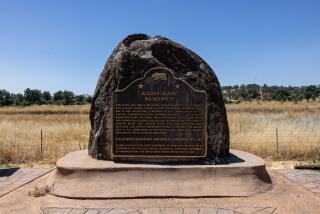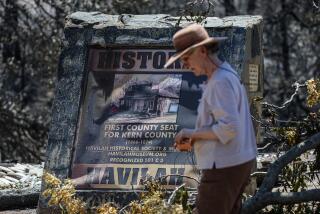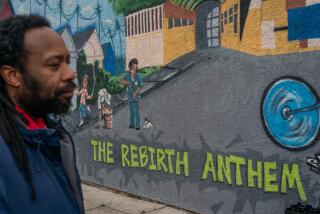Tiny Steelville Isn’t Just Surviving, It’s Thriving : Redevelopment: Town’s renaissance is based on commitment, hard work and ingenuity. A nucleus of its 1,470 citizens made difference.
- Share via
STEELVILLE, Mo. — This is the story of a town that nearly lost itself only to find how much it had. It is about a nucleus of citizens who made the difference between slow death and a life full of possibility. It is about commitment, hard work and ingenuity.
Most of all, it’s about hope.
The Census Bureau places Steelville’s 1,470 citizens at the geographic center of the nation’s drifting population. The honor, which came with a commemorative plaque a few years back, provided a nice little psychological boost. But the town’s renaissance was rooted in something else.
“It’s up by our own bootstraps,” said John Britton, who owns the local funeral parlor.
“We sensed we were dying--and that no one was going to salvage us. We had to do it ourselves,” added Ike Lovan, who owns a jewelry shop and local rooming house known as the White Eagle.
About an hour south of St. Louis, the town had some basic raw materials--a local newspaper, a shoe factory, a small machine tool company, a county courthouse, several churches and the Meramec River, which, along with a ring of wooded hills, was something of a tourist draw.
“We’re on the western frontier of the Ozarks,” Lovan said of the town, which runs a mile and a half from east to west. “Like the pioneers, we’re making our way. We see something out there, and we’re using our resources and people to get there.”
The big key to Steelville’s success has been the local telephone company, a cooperative that citizen shareholders for their own quirky reasons had always maintained independently. It was in many ways this bit of historical whimsy that gave the town its first break.
It started a few years ago with a gamble: The telephone company’s board risked $5,000 to buy a shot at a federal lottery for regional cellular phone rights--and won. Quickly reselling their license to a larger communications company netted a tidy profit of several million dollars.
A large chunk of that windfall was plowed immediately into a community development corporation, which since has provided seed money for a number of public projects. For starters, the town invested in state-of-the-art telephone technology.
It was a bargaining chip, something to offer prospective businesses in addition to enterprise-zone incentives like tax breaks and free property. With a telecommunications system sophisticated enough to compete with those in many major cities, Steelville would be a viable alternative for businesses looking to relocate.
Building on that idea, leaders figured good housing at affordable prices could only make the town still more appealing. So they set to work, designing a family-friendly housing development that might also attract retirees with disposable income. It didn’t hurt that with each new installation, the phone company’s assets would increase and the overall economy would grow.
Such enterprises, and the pooling of local resources, have driven a lot of Steelville’s best efforts.
Citizens got together to clean up Yadkin Creek, landscaping its banks and stocking it with trout. The Brown Shoe factory, which has grown from 300 to 600 employees while others in the region have been shut down, originally came to this town partly because a corporate executive born here lobbied for it.
A dentist who dreamed of having a country music show found a consortium of investors interested in buying an ugly, abandoned car dealership. It now is a motel with a 400-seat auditorium that draws steady summer crowds.
A coalition of churches runs a volunteer food pantry. Another group convinced Burlington Northern Railroad to donate a vintage caboose it plans to use either as an information bureau or jungle gym for kids. Technology buffs are setting up an interactive video resource center so citizens can tune in classes at any Missouri state university or browse through the Library of Congress.
“In some ways, this community is the model of what this country was like years ago: Life is on an intimate scale,” said the Rev. William Guyer Birch, co-pastor with his wife at the local Presbyterian church.
“You still have here everything you have in a city--crime, drugs, domestic troubles. The difference is, people here have taken the initiative. There are plenty of communities nearby where grass is growing up between the crumbling, abandoned stores.
“People knew things were changing. And they asked the important question: What are we changing to? Change is threatening. But we all still have to ask ourselves: What kind of people are we becoming?”
Perhaps the most obvious answer is on Main Street itself, where the newly refurbished shops all seem to be named for someone: Al’s Cafe, Bill’s General Store, Sherry’s Flowers, Nancy’s Antiques.
It started several years ago with a town dinner at the Golden Echoes retirement home, which in itself embodies the town’s entrepreneurial flair. Constructed with local money, the center includes a reception hall where residents cater events, using the profits to subsidize senior meals.
So at this dinner a few years back, fancy homemade hors d’oeuvres were served with wines from local vineyards. Merchants were shown an architect’s plans for returning Main Street to its historic roots. A local banker offered $500,000 in loans at 5%--half the going rate--to anyone who joined in the renovations. Nineteen shop owners immediately signed on, and the number soon doubled.
“Everybody wants to be part of something positive,” said Ed Leonard, who runs a graphics business and monthly tourism guide. “Five years ago, things here were desolate, abandoned. But we started out with a few people and watched most of the community join in.”
Of course, there are those who object. They see a self-interested cabal of self-styled community leaders out only for themselves. Most recently, a vocal group of naysayers opposed plans to build a new town pool to replace the decrepit one constructed in 1953. In a survey taken several years ago, 85% of the citizens said they wanted a new pool.
David Keymann, proprietor of the Rainbow Hotel, apparently was not among them: “Spend a half-million on a swimming pool? For who? Who’s going to pay for it?” he asked.
When the ballot came up, the group lobbying against won narrowly. The pool was dead, supporters thought. Until a local philanthropist stepped forward. He offered to match whatever funds the community could raise during 1993. Progress has been charted in posters around town.
By the end of the year, nearly $70,000 had been raised, bit by bit. At a community auction, a family offered a home-cooked gourmet meal that sold for $150. A local innkeeper offered a free night in a cabin and a canoe ride that fetched $200. And so it went.
The town raised $15,000 in one night, which has been added to the proceeds from an antique doll show, bake sales and other fund drives.
“In this town, if you have a problem and ask a hundred people for help, 80 or 90 will stand up and pitch in, whether it’s going to pick up rocks in the park or whatever,” said Bob Bell, 30, who grew up here.
Bell’s latest project has been Wildwood Springs. He sat one recent evening in one of the old rocking chairs he cherishes. Like the drafty old lodge, they are part of his dream. It was a ramshackle mess when he and some other family members formed a corporation to buy the place a year or so ago. They’d grown up across the street, watching its 1920s splendor fade along with the sound of the big bands that used to play on Saturday nights.
Buying Wildwood Springs was a bit cockeyed, Bell said. But he heard a voice not unlike the one that inspired Kevin Costner’s character in “Field of Dreams”: If you restore it, they will come.
He can see future seasons, hear the laughter of families like his gathering around the big hearth and ambling down the rambling lawn.
“We have a very strong ‘Take care of yourself’ attitude here,” said Bell, whose brother is mayor. “It’s a family. And the neat thing is, there’s more than one person pushing the buttons. We’ve got a community here and, to a lot of people, it’s worth working for.”
More to Read
Sign up for Essential California
The most important California stories and recommendations in your inbox every morning.
You may occasionally receive promotional content from the Los Angeles Times.










